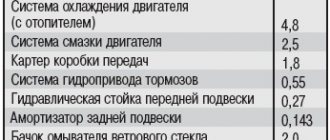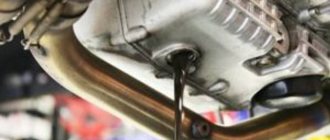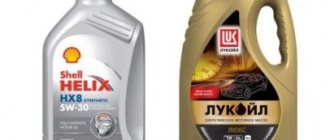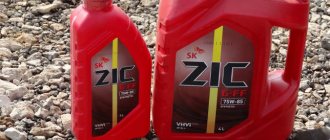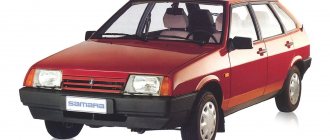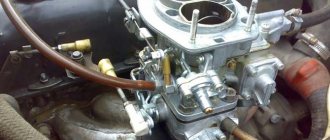Engine oil for VAZ 2106 engine
VAZ-2106 is a family of Soviet and Russian rear-wheel drive cars, presented on the market from 1976 to 2006. It is a continuation of the development of model 2103. The sedan of the same name was produced in Tolyatti, Izhevsk and Ukraine. The total production volume for all time amounted to 4.3 million copies. The car was equipped with a 1.6 petrol engine (78 hp), created on the basis of the 1.5 engine from 2103. In addition, a 63-horsepower 1.3-liter engine was also available. As of 1983, the VAZ-21063 cost 8,200 rubles, and the 2106 version was sold for 8,400 rubles.
Saturday, January 31, 2015
Refueling tanks VAZ 2106
The question often arises, especially among beginners, how much to pour a particular substance into the car’s filling tanks. For example, how much oil to pour into the gearbox or rear axle, how much oil to pour into the engine, etc. To do this, I will post instructions here, or rather, as written in the instructions, the volume of refills.
Fuel tank (including reserve 4-6.5 l) can hold 39 l Engine cooling system (including interior heating system) 9.6 l Engine lubrication system (including oil filter) 3.75 l Gearbox housing 1.35 l Rear axle housing contains on VAZ 2106-7 1.3L Steering gear housing 0.215L Hydraulic clutch release system 0.2L Hydraulic brake system 0.66L Front shock absorber 0.12L Rear shock absorber 0.195L Windshield washer reservoir 0.75L
These are the volumes that need to be observed when replacing substances. Naturally, the numbers are given according to the norm. Ideally, you can fill more or less, but you can damage the car.
Oil change period in the VAZ 2106 engine
When dealing with a used VAZ-2106 car, it is important to remember the annual oil change schedule, or every 10 thousand km. At the same time, it is also important to take into account the condition of the lubricant, which can be determined by the level of the liquid, its color and smell. If the corresponding signs are detected (turbidity, burnt smell, metal shavings and wear products in the form of sediment), the oil must be urgently replaced. This may need to be done after 6 thousand km, which is usually relevant for harsh operating conditions (sharp starts and braking, aggressive driving and non-compliance with traffic rules, driving on dusty roads and slushy terrain, towing heavy trailers, etc.).
Leaks and problems
The higher the mileage of the VAZ 2106, the more problems appear, as in principle with any car. Most often this is due to natural wear and tear of the engine, causing oil to burn. Although the manufacturer allows for a small consumption.
There can be many reasons why an engine eats oil. And in each case they can be individual. But, over the years of the model’s existence, we can talk about the most common places where leaks occur.
If the breather is spewing or throwing oil, or if there is oil in the exhaust manifold, this may indicate a serious problem with the oil rings. In this case, you can try decoking with dimexide. But it is better to use special auto chemicals designed for these purposes.
A leak from under the valve cover may be due to a worn gasket. Sometimes simply replacing the gasket does not solve the problem. Since the cover itself may have significant curvature. Therefore, in some cases it will have to be replaced.
A white emulsion in the engine or on the oil filler cap may indicate condensation. This is a common occurrence when temperatures change from minus to plus, mainly in autumn or spring.
But if the emulsion is also observed on the dipstick, then this is already a sign of more serious problems. Most often we can talk about a broken cylinder block gasket. And in rare cases, a cracked cylinder head may be to blame.
Also, with this problem, you can find oil in the expansion tank. Sometimes, simply replacing the gasket is not enough. It may be necessary to grind the head itself, and this is completely different money for repairs.
All this is general information, which may manifest itself differently on each specific vehicle, since everyone’s operating modes are different. The same applies to places of leaks or oil leaks. Therefore, it is impossible to identify the cause from a distance.
Source: autozaliv.ru
How much oil to pour into the VAZ 2106 engine
First generation 2106, 1975-2006
The VAZ-2106 was a modernized three-ruble car. The developers decided to slightly reduce the cost of the car's appearance by getting rid of unnecessary chrome elements. As a result, the car received new bumpers and front fascia, different rear lights and other minor external improvements. In addition, there are new door cards inside, as well as a hazard warning button on the front panel. After 1987, a 5-speed manual transmission began to be installed instead of a manual transmission-4, and in the 1990s the design and interior were significantly simplified - metal elements were replaced by plastic parts to reduce the cost of production. But the car received a heated rear window, a contactless ignition system, halogen headlights and new seat upholstery. In the last years of production, the 2106 was offered with an 80-horsepower 1.6-liter injection engine.
What oil to use for the VAZ 2106 engine
Original
VAZ-2106 owners use mineral, semi-synthetic or synthetic oil. Semi-synthetic is considered the most popular for this model. Regarding SAE viscosity, it should be noted that this parameter is selected based on temperature conditions. For example, for year-round operation, a 10W-40, 10W-30 or 5W-40 all-season oil is recommended. In the winter season, it is better to fill in 0W-30, 0W-40 or 5W-30, and in the summer you can opt for 20W-40 or 25W-50.
Unoriginal
Owners of VAZ-2106 cars prefer inexpensive motor oils from domestic brands Lukoil, Rosneft, G-Energy and Gazpromneft. When choosing a suitable product, it is necessary to take into account the API approval, which is selected depending on the year of manufacture of the car, as well as the type of internal combustion engine. For example, for a gasoline VAZ-2106 produced in 1976. All-season mineral oil with parameters 15W-20 and API-SG is suitable. For cars of the 2006 model year, semi-synthetic API-SJ is recommended. Below are the best options for analogue motor oils for the VAZ-2106.
- ZIC X5 10W-40
- Lukoil Lux 10W-40
- Mobil Super 3000 5W-40
- G-Energy 10W-40
- Eneos 10W-40.
Criteria for selecting VAZ 2106 oil
All oils are selected based on compliance with SAE, ACEA, API. In terms of composition, it is optimal to use semi-synthetics for used VAZs.
API SF for models up to 2000, for more recent API SG, SJ. VAZ 2106 was produced until 2006 inclusive.
AvtoVAZ offers the following table to select the appropriate viscosity:
| Minimum engine cold start temperature, °C | Viscosity grade according to SAE J 300 | Maximum ambient temperature, °C |
| -35 | 0W-30 | 25 |
| -35 | 0W-40 | 30 |
| -30 | 5W-30 | 25 |
| -30 | 5W-40 | 35 |
| -25 | 10W-30 | 25 |
| -25 | 10W-40 | 35 |
| -20 | 15W-40 | 45 |
| -15 | 20W-40 | 45 |
But most often, drivers pour 10w-40 into models with significant mileage, into more recent 5w-30.
Information on viscosity for a specific engine can be found in the motor oil interchangeability catalog: https://www.northsealubricants.com/en/oil-advisor
The catalog can be trusted, the data is taken from car manufacturers. In this case, you can choose not only oil for the engine, but also for the gearbox, power steering, brake system, and cooling system. That is, all liquids.
Instructions
- We warm up the engine to 45-50 degrees. Warm oil has better fluidity and will drain better from the engine during a complete replacement. Our task is to remove as much as possible the old dirty and used fluid that no longer has useful properties from the engine and fill it with new one. If a lot of old dirty oil remains in the crankcase, it will be swept away with the new one and will worsen its beneficial properties. Warm up the engine for 5-7 minutes before starting, this will be sufficient.
- For easy access to the drain plug (and in some models the oil filter is also attached from the bottom) and the bottom of the car as a whole, you need to jack it up or drive into an inspection hole (the best option). Also, some models may have engine crankcase “protection” installed.
- We open air access to the crankcase by unscrewing the filler cap and dipstick.
- Place a large container (equal to the amount of oil being poured).
- Unscrew the drain plug with a wrench. Sometimes the drain plug is made like a regular “bolt” under an open-end wrench, and sometimes it can be unscrewed using a four- or hexagon. Don't forget to wear protective gloves, the oil will most likely wake you up warm, but you need to be careful.
- We wait about 10-15 minutes until the waste flows into a basin or cut-off plastic canister.
- Optional but very effective! Flushing the engine with a special liquid is not included in the maintenance regulations and is not mandatory - but. By getting a little confused, you will be much better at flushing out the old, black oil from the engine. In this case, wash with the old oil filter for 5-10 minutes. You will be surprised at the black oil that comes out with this liquid. This liquid is very easy to use. A detailed description should appear on the flushing fluid label.
- Changing the sedum filter. In some models, it is not the filter itself or the filter element (usually yellow) that is changed. Impregnating the filter with new oil before installation is a mandatory procedure. Lack of oil in the new filter before starting the engine can cause oil starvation, which in turn can cause filter deformation. Overall this is not a good thing. Also remember to lubricate the rubber O-ring before installation.
- Fill in new oil. Having made sure that the drain plug is screwed in and a new oil filter is installed, we can begin to fill in new oil using the dipstick as a guide. The level should be between the minimum and maximum marks. Also, you need to remember that after the first start of the engine, some oil will leave and the level will drop.
- In the future, when the engine is running, the oil level will probably change; be careful during the first few days of operation. Recheck the oil level using the dipstick after the first start.
Oil volume in the VAZ 2106 engine
| Engine | hp | Year of release (beginning-end) | Engine oil volume, l | |||
| 1.3 | B | VAZ-21011 | 64 | 1976 | 1993 | 3.75 |
| 1.45 | B | VAZ-2103 | 73 | 1976 | 1988 | 3.75 |
| 1.6 | B | VAZ-2106 | 76 | 1976 | 2001 | 3.75 |
How to choose
In order not to make a mistake with your choice, you need to consider three aspects:
- what year of manufacture is the engine, what is its modification and how worn is it;
- in what weather conditions the car is operated;
- Does the engine have hydraulic compensators that control valve clearances?
The fact is that engine models that were produced before the 90s were equipped with oil seals and valve stem seals made of nitrile rubber. This material cannot interact with synthetic and semi-synthetic products.
Also, if hydraulic compensators are installed, then high-viscosity grades cannot be used. This applies to all types of engines, including modern ones.
In order not to make a mistake with your choice, it is best to look at the service documentation of your instance. This is where the permissible viscosity values, API, ACEA or ILSAC, as well as GOST are located. Of course, specific recommendations are likely to be outdated. But by understanding what characteristics a lubricant should have, you can buy from the modern assortment what is right for you.
If you still don’t know what oil to pour into the engine, you can use our reminder:
How much oil is in the VAZ 2106 engine
VAZ-2106 is a compact rear-wheel drive car produced since 1975. The car was a modernized version of the VAZ-2103. Among the external improvements, we note the bumpers, front fascia and rear lights, and the interior has improved door trim and a hazard warning light button. The 1.6-liter gasoline engine developed 78 hp. With. It was designed on the basis of a 1.5-liter internal combustion engine from the VAZ-2103. However, the VAZ-21061 modification received the engine from its predecessor, and the VAZ-21063 version was equipped with a 1.3-liter internal combustion engine with a power of 63 hp. With. The design of the car stood out with minor improvements.
In 1987, the VAZ-2106 began to be equipped with a five-speed manual transmission (previously there was a 4-speed manual transmission). At the end of the 1980s, the trim of the interior and body was slightly simplified, but in the early 1990s, power windows appeared. In the period 1993-2001, they offered a modernized version of the VAZ-21065 with a heated rear window, contactless ignition, halogen optics and other seat upholstery.
As of 1983, model 21063 cost 8,200 rubles, and version 2106 was sold at a price of 8,400 rubles. In 1998, the “six” entered the production line in Syzran. In 2001, the production of the car was completed on the main assembly line in Tolyatti. In the last years of production, the car was available with a 1.6 liter (80 hp) injection engine. In 2006, the car finally left the assembly line. The total production volume was almost 4 million cars.
Source


